Bryanna Clark Grogan’s Vegan Feast Kitchen/ 21st Century Table: The kitchen journal of a vegan food writer.. I'm on Facebook and Twitter (see links in sidebar at right).
Friday, August 31, 2007
CHANTERELLE TIME AGAIN!

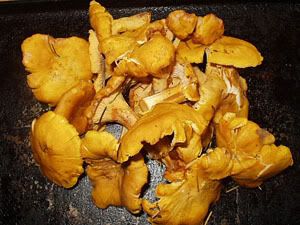
Fresh chanterelles picked on Denman Island.
Since this has been a mixed-bag of a summer, with lots of rain interspersed with heat, chanterelle mushrooms are popping up all over, except in our area (some years we get some, and other years, nothing). Our friends Jane and Matzuki have the "motherlode" of chanterelle patches and, fortunately for us, pick more than they can use! They share lots of their bounty with us! (I saw them for sale online for $25 a lb.!) I use them in risotto and sautes, and I slice mounds of them and cook them in oil in a hot oven in a large baking pan to freeze for later use. But one of our favorite uses for chanterelle mushrooms is in classic Mushroom and Barley Soup, which we had last night for dinner, and again for lunch today.
(BTW, 5 medium chanterelles, or about 3 oz., contains only 25 calories and 3 g of protein.)
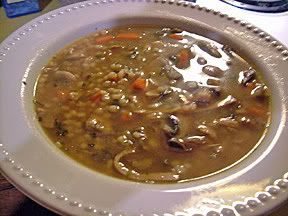
Printable Recipe
BRYANNA'S CLASSIC MUSHROOM AND BARLEY SOUP (You can make this with other mushrooms, too!) A WW CORE PLAN-COMPATIBLE RECIPE
serves 8
Adapted from my book "The Fiber for Life Cookbook".
This is a very rich-tasting soup, very comforting. It’s one of my absolute favorites. This version is a typical Eastern European variety, but you can add a few cooked beans or slivered tofu for extra protein, if you like. I have streamlined this recipe from the book a little.
1/2 oz. dried boletus or porcini mushrooms, broken up
2 T. olive oil
1 large onion, thinly sliced
2 stalks celery with leaves, chopped
1/4 c. parsley, chopped
2 carrots, scrubbed and diced
3-4 cloves garlic, chopped
1 lb. fresh sliced chanterelle, crimini (brown button), or portobello (large brown) mushrooms
10 c. vegetarian "chicken" broth
1-2 tsp. Marmite,Vegemite or other yeast extract (or 2-4 tsp. dark or red miso)
1 c. pot barley (also called hulled barley)
OPTIONAL:
1 c. cooked or canned soybeans or black-eyed peas, rinsed and drained, OR 6 oz. firm tofu, cut into slivers
salt and pepper to taste
Soak the dried mushrooms in boiling water to cover for 1/2 an hour. Meanwhile, heat the olive oil in a large soup pot and saute the onion, celery, 2 T. of the parsley, carrots, garlic, and fresh mushrooms for about 5 minutes. Slowly add the broth.
Strain the dried mushrooms and reserve the water. Chop the mushrooms and add them to the pot along with the reserved water, barley, and yeast extract or miso. Add optional the beans or tofu, if using. Bring to a boil, then reduce heat, cover and simmer 1 hour. Taste for salt and pepper.
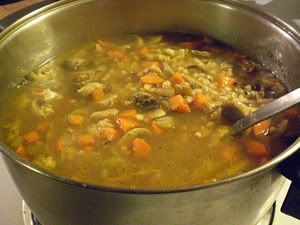
If the soup is too thick for your liking (it thickens up when cooled), just add some more broth.
Servings: 8
Nutrition Facts
Nutrition (per serving): 147.9 calories; 24% calories from fat; 4.2g total fat; 0.0mg cholesterol; 80.6mg sodium; 463.2mg potassium; 24.1g carbohydrates; 5.8g fiber; 3.2g sugar; 18.3g net carbs; 5.7g protein; 2.5 points.
Enjoy!

BRYANNA'S CLASSIC MUSHROOM AND BARLEY SOUP (You can make this with other mushrooms, too!) A WW CORE PLAN-COMPATIBLE RECIPE
serves 8
Adapted from my book "The Fiber for Life Cookbook".
This is a very rich-tasting soup, very comforting. It’s one of my absolute favorites. This version is a typical Eastern European variety, but you can add a few cooked beans or slivered tofu for extra protein, if you like. I have streamlined this recipe from the book a little.
1/2 oz. dried boletus or porcini mushrooms, broken up
2 T. olive oil
1 large onion, thinly sliced
2 stalks celery with leaves, chopped
1/4 c. parsley, chopped
2 carrots, scrubbed and diced
3-4 cloves garlic, chopped
1 lb. fresh sliced chanterelle, crimini (brown button), or portobello (large brown) mushrooms
10 c. vegetarian "chicken" broth
1-2 tsp. Marmite,Vegemite or other yeast extract (or 2-4 tsp. dark or red miso)
1 c. pot barley (also called hulled barley)
OPTIONAL:
1 c. cooked or canned soybeans or black-eyed peas, rinsed and drained, OR 6 oz. firm tofu, cut into slivers
salt and pepper to taste
Soak the dried mushrooms in boiling water to cover for 1/2 an hour. Meanwhile, heat the olive oil in a large soup pot and saute the onion, celery, 2 T. of the parsley, carrots, garlic, and fresh mushrooms for about 5 minutes. Slowly add the broth.
Strain the dried mushrooms and reserve the water. Chop the mushrooms and add them to the pot along with the reserved water, barley, and yeast extract or miso. Add optional the beans or tofu, if using. Bring to a boil, then reduce heat, cover and simmer 1 hour. Taste for salt and pepper.

If the soup is too thick for your liking (it thickens up when cooled), just add some more broth.
Servings: 8
Nutrition Facts
Nutrition (per serving): 147.9 calories; 24% calories from fat; 4.2g total fat; 0.0mg cholesterol; 80.6mg sodium; 463.2mg potassium; 24.1g carbohydrates; 5.8g fiber; 3.2g sugar; 18.3g net carbs; 5.7g protein; 2.5 points.
Enjoy!

Friday, August 24, 2007
PHOTOS FROM A FAMILY VEGETABLE DINNER
 My sister and brother-in-law were visiting for a couple of days. They are vegans (well, he is almost!) and they like lots of veggies, fruits and grains. Luckily, this is the time of year when we have a vegetable bounty on Denman Is.! The corn is ready, and there are zucchinis, tomatoes, green beans, etc.. So here is a dinner we had:
My sister and brother-in-law were visiting for a couple of days. They are vegans (well, he is almost!) and they like lots of veggies, fruits and grains. Luckily, this is the time of year when we have a vegetable bounty on Denman Is.! The corn is ready, and there are zucchinis, tomatoes, green beans, etc.. So here is a dinner we had: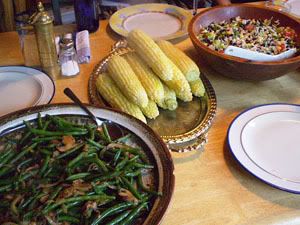
Fresh green beans braised with browned onions, sauteed mushrooms and mushroom broth; fresh corn on the cob (or "corn on the nob" as my 3 yr-old grandson says!); and a rice and black bean salad I threw together with leftovers.
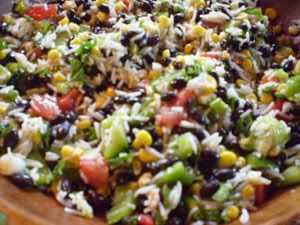

rice salad; rosemary roasted potatoes; and roasted beets with olive oil, balsamic vinegar and parsley.
It was yummy!

Saturday, August 18, 2007
ZUCCHINI DAZE


Sauteed green and yellow zucchini
This is the time when zucchini shows up everywhere. I don't grow it because my neighbors and patrons at the library where I work give it to me! Personally, I like zucchini as a vegetable, so I don't generally use it in cakes, muffins, and the like. I'd like to share a couple of really delicious zucchini recipes with you (plus a cucumber recipe) that we've enjoyed lately.
Does zucchini have any real nutrients? They have a high water content (more than 95 percent), so zucchini are very low in calories. There are only 13 calories in a half-cup of raw zucchini, with a slight increase to 18 calories in the same quantity cooked. Nutritionally, zucchini offers valuable antioxidants. They also provide some beta-carotene, trace quantities of the B vitamins, folic acid, small amounts of vitamin C and calcium, and a healthy content of potassium.

Printable Recipe
BRYANNA'S DELICIOUS ZUCCHINI BISQUE (can be soy-free)
From my book "The Fiber for Life Cookbook".
This is abslolutely delicious and it uses up lots of zucchini-- try it! PS: There's a new version I did with roasted zucchini at this link-- the flavor is a bit different! Both are delish.
2 1/2 lbs zucchini (unpeeled), cubed (any size, but with tender skin, that you can scrape easily with your fingernail)
3 Tbs extra-virgin olive oil
4 cloves garlic, minced
2 3/4 cups vegetarian broth
3 Tbs nondairy milk blended with
3 Tbs silken tofu or raw cashews (soak cashews in hot water for 10 minutes)
salt and freshly-ground pepper to taste
vegan parmesan substitute (we like GoVeggie! vegan brand)
Heat the olive oil in a medium pot. Add the zucchini cubes and garlic and saute over medium heat for 10 minutes. Don't brown it.
Add the broth and simmer for 5-10 minutes. Puree 2/3 of the mixture in a blender (take the middle part of the lid off to allow hot steam to escape and cover it loosley with a folded tea towel) and then add back to the pot. OR you can puree it right in the pot with a hand immersion blender, leaving it slightly coarse.
Add the "cream" made from the blended milk and tofu or cashews, and taste for salt and pepper. Heat briefly. Serve with vegan parmesan sprinkled on each serving.
Servings: 6
Nutrition Facts
Nutrition (per serving): 121.9 calories; 52% calories from fat; 7.3g total fat; 0.0mg cholesterol; 50.6mg sodium; 523.6mg potassium; 12.9g carbohydrates; 3.1g fiber; 3.5g sugar; 9.8g net carbs; 3.6g protein; 2.4 points.
***************************************************************
Next come two recipes adapted from my latest cookbook purchase, "Arab Cooking on a Saskatchewan Homestead", by one of my favorite cookbook authors, Habeeb Salloum.

It's a fascinating book, a combination of Canadian history and Arab cooking! Mr. Salloum's parents emigrated to the Canadian Prairies from Syria in the 1920's, as did many thousands from that part of the world. We never hear anything of this, so it is a fascinating story! He relates how they grew chickpeas and lentils and fava beans, unknown to Canadians then, but now grown extensively in the Prairie Provinces, and made their own bulgur wheat. Most of the recipes are ones that his mother made, which sustained them well during the Great Depression. It's not a vegetarian cookbook, but the largest proportion of recipes is vegetarian.
BTW, I don't (obviously) just read vegetarian and vegan cookbooks! I think you miss out on alot when you confine yourself in that way, especially when it comes to ethnic cooking.
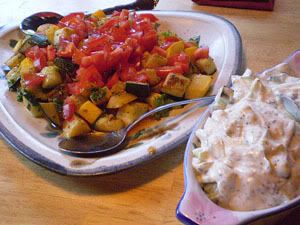
Warm Zucchini Salad and Vegan Garlic-Cucumber-"Yogurt" Salad
Printable Recipe
HABEEB SALLOUM'S WARM ZUCCHINI SALAD (WW CORE PLAN-COMPATIBLE)
From the book "Arab Cooking on a Saskatchewan Homestead" by Habeeb Salloum (see above). (I made only a few slight changes.) This is a fantastic way to enjoy fresh zucchini!
2/ 8"-long zucchini, diced 1/2"
2 Tbs olive oil (Mr. Salloum called for 4 Tbs.)
2 cloves garlic, crushed
1/2 tsp salt
1/2 tsp freshly-ground pepper
1/2 tsp ground fennel (grind seeds in a coffee/spice mill)
2 Tbs chopped cilantro (I used parsley and mint)
2 Tbs fresh lemon juice
1 medium ripe tomato, chopped
Mr. Salloum said to peel the zucchini, but I didn't. It is pretty with a combination of green and yellow zucchini.
Heat the oil in a large nonstick skillet over medium-high heat. Add the zucchini and stir-fry until they start to soften a bit (but don't let them cook through and don't brown them!).
Transfer to a bowl and add the remaining ingredients EXCEPT the tomato. Toss well.
Spread on a platter and sprinkle with the tomato. Serve at room temperature.
Servings: 4
Nutrition Facts
Nutrition (per serving): 87.1 calories; 71% calories from fat; 7.1g total fat; 0.0mg cholesterol; 248.5mg sodium; 365.0mg potassium; 6.0g carbohydrates; 1.7g fiber; 2.7g sugar; 4.3g net carbs; 1.7g protein; 2.0 points.
Printable Recipe (Includes recipe for Cashew Sour Creme or Yogurt)
VEGAN CUCUMBER-GARLIC-"YOGURT" SALAD (pictured above with the zucchini salad)
This is a veganized version of a delicious, creamy Middle Eastern salad. This is adapted from a dairy-based recipe in Habeeb Salloum's book, "Arab Cooking on a Saskatchewan Homestead".
2 cucumbers, about 8" long each (see NOTE below)
2 cloves garlic, crushed
2 Tbs fresh mint, chopped (or 2 tsp. dried)
2 Tbs olive oil
2 Tbs cider vinegar
1/2 tsp salt
freshly-ground black pepper to taste
1 cup Tofu Sour Creme (homemade or commercial)
(Cashew Sour Crème [recipe below] is also excellent in this recipe-- see below for Nutrition Facts using Cashew Sour Creme.)
(NOTE: Peel and seed the cucumbers only if necessary. I use English cucumber, or the type you don't have to peel and seed-they are sometimes called "seedless", though they do have tiny, edible, seeds, or "burpless", or "European"or "greenhouse", or "hothouse", or "gourmet" cucumbers,. You could also use "Armenian cucumbers", or"snake cucumbers".)
Slice the cucumber into thin rounds, then slice them in half (or you can dice them small, if you prefer). Combine the remaining incredients and then toss them with the cucumbers in a serving dish. Chill before serving.
Servings: 8
Nutrition Facts
Nutrition (per serving): 55.7 calories; 57% calories from fat; 3.7g total fat; 0.0mg cholesterol; 187.2mg sodium; 141.0mg potassium; 4.1g carbohydrates; 0.4g fiber; 1.7g sugar; 3.6g net carbs; 2.6g protein; 1.3 points.
NUTRITION FACTS USING CASHEW SOUR CREME:
76.7 calories; 69% calories from fat; 6.2g total fat; 0.0mg cholesterol; 162.6mg sodium; 163.4mg potassium; 5.2g carbohydrates; 0.6g fiber; 1.8g sugar; 4.5g net carbs; 1.6g protein; 1.9 points.
Printable Recipe (just the Cashew Sour Creme recipe)
BRYANNA'S CASHEW SOUR CRÈME (OR "YOGURT") (wheat-free and soy-free)
This is a delicious dairy AND soy-free vegan product.
1/2 cup raw cashew pieces
1 cup water
1/4 tsp salt
1/4 cup original nondairy milk
2-3 Tbs lemon juice
Blend the cashews, water and salt in a blender for several minutes, or until VERY smooth. Pour the mixture into a heavy medium saucepan and stir over medium-high heat until the mixture thickens considerably. DO NOT ALLOW TO BURN or the taste will be awful!
MICROWAVE OPTION:
Pour the mixture into a microwave-safe bowl and cook on HIGH for 2 minutes, or until quite thick.
With a wire whisk, whisk in the lemon juice (to taste) and the milk until smooth. Place in a covered container and chill. If it's too thick after chilling, add a little water or more non-dairy milk.
For the "yogurt"variation, use just a pinch of salt and use water to thin the mixture to the consistency you want. Add a little more lemon juice if you want more "tang". If you like, you can add some dairy-free acidopholis powder.
Servings: 6
Yield: 1 1/2 cups
Nutrition Facts
Nutrition (per 1/4 cup): 67.3 calories; 67% calories from fat; 5.4g total fat; 0.0mg cholesterol; 86.3mg sodium; 87.5mg potassium; 3.8g carbohydrates; 0.4g fiber; 1.1g sugar; 3.4g net carbs; 2.1g protein; 1.7 points.
Enjoy!

Sunday, August 12, 2007
MORE ADVENTURES IN MIDDLE EASTERN COOKING: POTATO KIBBI/KIBBEH

I had to make some finger food for a fundraising event I organized last week and I didn't want to just make the usual things. I have been wanting to try this kibbeh/kibbi recipe for a long time, so I made two pans of it, and it was so superior to any other vegetarian kibbeh I have ever tried. We loved it, and everything I brought sold out, even though most people had no idea what it was! It's the large amount of onions, cooked in the olive oil, that makes it so tasty and moist, I'm positive!
I often serve this recipe at big family gatherings and everyone loves it-- even if they don't know what it is!
 |
| An Easter dinner with Potato Kibbeh in the foreground |
ABOUT KIBBEH/KIBBI:
The Arabic word kubbeh means a ball. The name has been widely borrowed, with various spelling variations: in English, the spellings kibbe and kibbeh are both common; also kubbah and kibbi. In Brazil, it is called quibe or kibe; elsewhere in Latin America, kipe or quipe. In Turkey, it is called içli köfte. In Armenian, it is called kufteh.
PRONUNCIATION: There is a little hesitation between the two b’s, and the second syllable is pronounced with a short e. It should look like this: kib’beh.
Kibbeh is defined as a dish of minced meat with bulgur and spices with many variants, both raw and cooked. However, there are several popular vegetarian versions (Lenten versions for Christians, usually) made with potato, pumpkin, sweet potato, etc, with plenty of onions for flavor. Many chefs are experimenting with stuffed vegetarian kibbi, utilizing greens, pomegranate molasses, nuts, herbs., etc.
It is a popular dish in the Levant, sometimes considered the national dish of Lebanon, Syria, Palestine, and Iraq. It is also a common food in North Africa, Turkey, the Arabian Peninsula, and parts of the Caucasus, such as Armenia and Georgia. Like hummus, everyone’s mom does it best.
In its most common form, it consists of minced meat mixed with bulgur and spices, stuffed inside a bulgur crust. The shape, size and ingredients vary between different types of kibbeh and between the recipes traditional in different areas. Recipes can include pine nuts, and green herbs, among other things. It can be baked, fried, boiled, stuffed, or served raw. The mix of spices changes as does the composition of the crust. Kubbat Halab is an Iraqi version made with a rice crust, though apparently not originating in the Syrian city of Halab (Aleppo) as its name suggests. Kubbat Mosul is another Iraqi version originally from Mosul where a bulgur crust is used, but the shape is flat and round, like a disc. Finally, Kubbat Shorwa is an Assyrian-Iraqi version where kibbeh is mixed in a stew, usually cooked with tomato sauce and spices.
It is traditionally served with a tahina dip which is made with sesame seed paste.
Besides being found in the Middle East and in Middle Eastern restaurants world-wide, it has also become a popular dish in South America, where it was introduced by Lebanese and Palestinian immigrants.
Information sources:
http://toughtimesbeirut.blogspot.com/2007/01/kibbeh.html (link no longer works)
http://www.answers.com/topic/kibbeh-1?cat=health
Printable Recipe
POTATO KIBBI (KIBBIT BATATA BIS-SAYNIYYI)
Serves 8
This is adapted from a recipe in the excellent book "Lebanese Cuisine" by Madelain Farah.
I have tried other potato kibbi recipes, but this one is absolutely the best! Good hot or at room temperature, plain, or with vegan Taheena Sauce.
1 1/2 cups bulgur wheat (#2 or medium-fine)
2 tsp salt
1 Tbs chopped fresh basil (or 1 tsp. dried) (NOTE: mint or cilantro or oregano can also be used)
1/8 tsp cinnamon
1/8 tsp freshly-ground black pepper
1 small onion, grated
4 medium (4 oz. each) potatoes (I used Yukon Gold), cooked tender, then peeled and mashed (NOTE: To peel the hot cooked potatoes, hold under running cold water and the skin will peel off easily.)
2 large onions, thinly sliced
2/3 cup oil (I used olive oil), divided
Rinse the dry bulgur in cold water, squeeze, sprinkle with salt and let stand for 20 minutes.
Work seasonings with grated onion and add the mashed potatoes, mixing well. Add the bulgur and knead into soft dough. Moisten hands in cold water while kneading to prevent sticking. ( If mixture doesn't stick together, add 1/4 cup of flour-- but I didn't have to add any.)
Place the sliced onions in the bottom of a 9" square baking pan (spray the sides with oil). Cover with 1/3 cup of the oil.
Place the potato mixture evenly on top of the onions, smooth down, and cut into diamond shapes about 1/2" deep. Pour the remaining oil on top and bake at 400° until golden brown - about 50-60 minutes.
Let cool until you can handle it and cut the diamond shapes all the way down.
Variation:
Use above recipe omitting oil and sliced onions. Form the mixture into patties and fry in 1/2" of oil or place on a well-oiled pan and bake.
Servings: 8
Nutrition Facts
Nutrition (per serving): 315.8 calories; 51% calories from fat; 18.5g total fat; 0.0mg cholesterol; 478.5mg sodium; 381.5mg potassium; 35.4g carbohydrates; 6.4g fiber; 2.3g sugar; 29.0g net carbs; 4.7g protein; 7.1 points.
Enjoy!
Friday, August 3, 2007
WATER, WATER, EVERYWHERE??


Today, this story was making the headlines: "NEW YORK - So you thought that water in your Aquafina bottle came from some far-away spring bubbling deep in a glen? Try the same place as the water in your tap.
PepsiCo Inc. is the latest company to offer some clarity about the source of its top-selling bottled water as it announced on Friday it would change the label on Aquafina water bottles to spell out that the drink comes from the same source as tap water."

Want to know more about this important issue? Watch the video below, an interview with Brian C. Howard, author of the article "Message in a Bottle".
Here is the report mentioned in the video, by the Natural Resources Defense Council, "on the results of our four-year study of the bottled water industry, including its bacterial and chemical contamination problems. The petition and report find major gaps in bottled water regulation and conclude that bottled water is not necessarily safer than tap water."
AND, WATCH THIS HUMOROUS, YET VERY REVEALING, VIDEO. (Caution-- swearing in this second video, but it's worth watching; I'm just warning you in case it might offend you.)
We are being duped, something I've believed for a long time. This video shows the extreme to which this has gone.
More articles:
Bottled Water Isn't Healthier Than Tap, Report Reveals
Bottled Water and Snake Oil
Pouring Resources Down the Drain
Please remember that we in North America and Europe are blessed with an abundance of clean water. Let's be thankful that we are not in Baghdad, where some neighborhoods have been dry for a week, and those that have it risk illness if they drink it. The electricity grids are so strained that they can't be used for water purification! So, let's get some perspective.

However, I know that not everyone has good water. Some of the water here on Denman Island, where most of us have wells, is delicious (like ours) and some has such a strong smell of sulphur that you can't drink it. What do you do? Consider Earth Water. (Hat Tip: my good friend Fireweed)
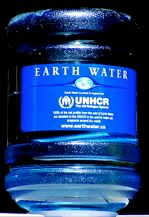
"Did you know...
...that globally, there are 6000 deaths daily, and 2.2 million annually - all due to the lack of clean drinking water?
...In the past 10 years, water related diseases have amounted to more deaths among children than the combination of all the deaths attributed to armed conflict since the Second World War.
Earth Water International is a bottled water company; a new type of corporation whose bottom line is to help save the lives of people in the most desperate of situations.
Earth Water works in support of the United Nations Refugee Agency (UNHCR) by donating 100% of it's net profits to be used in water aid programmes in developing countries.
Unlike other corporations, Earth Water's shareholders are every man, woman and child living in the most desperate of situations. Earth Water makes all of its corporate decisions by considering how our policies will impact our world and the people around us.
...our profitability is gauged by how well our corporation is able to positivley impact the lives of citizens around the world and by maintaining sustainable economic practices."

"Access to water is a basic human right. Ensuring refugees have an adequate supply of clean fresh water is the UNHCR’s top priority. Water is brought immediately to refugee camps by using trucks. Over long periods of time, UNHCR sets up permanent, sustainable and cost-effective water supply systems.
The UNHCR cares for 20.8 million people in 117 countries.
Of that 20.8 million people:
8.4 million are refugees
6.6 million are internally displaced persons
5.8 million are stateless, refugees who have returned home but need assistance, asylum seekers, or are others of concern"
UN "Water for life" website and their "Kids' Corner" with lots of resouces for students. This site has information on all of the issues around water, including gender issues.
Check the Earth Water website for where you can find it all over the world. They have cooler systems, as well as bottles.
So, if we MUST use bottled water (and we all do from time to time-- on trips, etc.), let's make sure the profits are not going to a big soft drink conglomerate like Pepsi (sells "Aquafina") or CocaCola (sells "Dasani"), or HUGE big business like Nestle, which sells "Pure Life"! Let's make the profits work for those who have no access to clean water!
ALTERNATIVES TO BOTTLED WATER?
Of course, the ideal would be for everyone to have access to free, clean, safe tap water for drinking. Even non-profit bottled water is not the answer! The Natural Resources Defense Council (their report on bottled water is the subject of the video below) has an excellent page on water, and issues such as activism, fighting and preventing pollution, and water conservation and restoration. They have a page called "Consumer Guide to Water Filters: How to find the right water filter for your home". "NRDC is working toward the day when all Americans can drink and shower in tap water without worry, but if you have immediate concerns about the water in your home, an independently certified water filter can be a good temporary fix for your kitchen faucet. Some filters aim to produce clearer, better-tasting water, while others work to remove contaminants that could affect your health. This guide will help you determine what type of filter might be right for your home."
They also have a page on "How to Clean Up Our Water: Twelve simple ways you can help stem the tide of polluted runoff" (These are available in Spanish and English.)
Peace/Shalom/Salaam

"MESSAGE IN A BOTTLE" VIDEO:
NOTE: My vegan Peruvian recipes are featured on a blog post at the wonderful blog Peru Food! It's a real honor to be featured there!
Subscribe to:
Comments (Atom)



